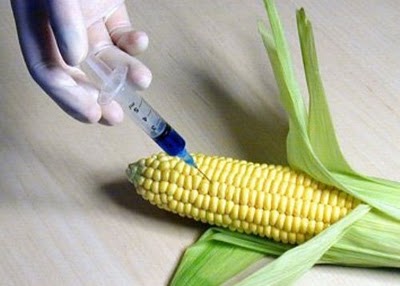Do you have any idea how much of the food you eat is genetically modified?? If your answer is no, or if you have never stopped to consider it, join the club. Most Americans have no idea that majority of what they eat is indeed “frankenfood.” Even if you are in the small group of concerned GMO-aware consumers, it still can take some serious leg work to ensure that you avoid eating fake foods and get your natural fix. Several weeks ago, I wrote a long form paper on the dangers of GMO’s. Below is an excerpt from the paper. It’s longer than my usual posts, but if you do not know much about GMOs or even if you think you do, I encourage you indulge me. It may cause you to think twice about what you put in your shopping cart. -XoXo Raw Girl
In our modern day maelstrom of technology and innovation, genetically modified organisms have become commonplace, although they were once thought highly unnatural. A genetically modified organism (GMO) is defined as an “organism whose genetic material has been altered using genetic engineering techniques.” Organisms that have been genetically modified include microorganisms like bacteria and yeast, insects, plants, fish, and mammals. It is also commonly defined as: “any living organism that possesses a novel combination of genetic material obtained through the use of modern biotechnology.” According to the Grocery Manufacturers Association,” Seventy-five to eighty percent of all processed foods available on grocery store shelves contain GMOs.” In addition the USDA has stated that an estimated ninety four percent of soy and seventy five percent of all corn produced in the U.S. are genetically modified organisms. Most Americans have no barometer as to whether or not the food they are consuming is natural or unnatural. As an average consumer, if you were to closely assess all food intake that may contain GMOs, you may be shocked to discover that the majority of the foods you consume daily are genetically engineered. Although genetically engineered plants and animals have been approved for sale and consumption, genetically modified plant and animal species can have deleterious effects on the environment and on the lifespan of humans.
From prehistoric times until the 1900s humans generally lived on food that was gathered from nature. Around 1900, some variations of species or hybrids were discovered. In 1953, scientists documented their discovery of the three dimensional double helix structure of DNA, but it wasn’t until 1973 that scientists created the first successful recombinant DNA organism or man-made DNA. At the Asimolar Conference in 1975 a group of biologists, lawyers, and doctors convened to create guidelines for safe use of genetically engineered DNA. Five years later the first patent of GMO organisms was issued and in 1992 the FDA declared that genetically engineered foods are “not inherently dangerous” and do not require special regulations. Two years later in 1994 the FDA approved the first genetically modified food to go to market; the Flavr Savr tomato which had delayed ripening. In 1997, due to the overwhelming proliferation of GMOs the European Union ordered mandatory labeling of all GMO foods including animal feed. By 1999, over 100 million acres all of the world were planted with genetically engineered seeds and stores were stocked full with GMO foods.
Since the inception of man-made DNA leading into the present day where GMOs are commonplace, the United States and the FDA has not called for special regulations nor required mandatory labeling of all GMO foods. Even more important to note, no clinical trials of genetically engineered foods have been conducted to investigate and prove the claims the FDA made about GMOs not having any serious effects on health. Although the European Union has been labeling and creating a transparent system to warn and inform consumers since 1997, the average American consumer has no way to be one hundred percent sure what is in their food without extensive research.
If you look at the trends in health in the United States since the mid 1990’s you will discover that the number of Americans suffering from at least three chronic diseases almost doubled, infant mortality rate has increased, and life expectancy has decreased. Jeffrey Smith, filmmaker and author of Genetic Roulette: The Documented Health Risks of Genetically Engineered Foods, asserts that all of these changes in the health of America are due to the change in our food supply. Genetic engineering and GMOs have been the most drastic and major change to the U.S. food supply within this time period. In addition to the increase in chronic diseases the number of people contracting autoimmune disorders has increased exponentially. Genetically engineered foods, are foods that are created by combining or essentially mixing and matching genes from genetically modified organisms. Therefore the final product is something non-existent in nature and foreign to our bodies’ code. Autoimmune disorders occur when the the body begins to attack itself, or is unable to distinguish between foreign and normal matter. If the body takes in food that is unnatural and does not recognize the code it begins to attack it as if it is a foreign invader or toxin, which throws the body into defense mode. An inflammatory response is created, which is the main culprit for all chronic diseases.
In addition to this, in a report entitled “GMOs and Truths,” it was discovered and proven that most of the myths that claim that GMO foods are safe are actually false. GMO foods are less nutritious than organic natural non-engineered foods, they pose real dangers to human health and harm the environment and farmers. With these truths exposed there is a clear moral and ethical dilemma that has yet to be addressed while the FDA and other organizations and brands continue to advertise that GMOs pose no serious threats to long term health, allow for false and misleading advertising to consumers, and do not impose regulations that would at the very least allow each consumer to make a personal and informed decision on whether or not to consume genetically engineered foods. The two major GMO crops are soy and corn. In a scientific study conducted on female rats, the rats who were fed a diet of GMO soy experienced a drastically higher infant death rate. The infants that did survive were smaller and less fertile than the rats fed a diet of non-GMO soy. Male rats when fed GMO soy had a complete color change in their testicles and their diet caused damage to their sperm. Other problems related to fertility have been documented in animals that are fed GMO corn and cottonseed as well. In another study, French researchers discovered that rats who were fed high doses of Monsanto’s GMO corn contracted tumors and also suffered from damage to multiple organs.
Beyond human health, the planting of genetically engineered crops and the farming of animal products has been proven to have adverse effects on our environment. Some of the most dramatic effects documented by scientists include the evolution of GMOs into “superweeds,” the ability for GMO crops to cross pollinate and contaminate normal organic crops producing undesirable genetic traits, and the general harm that can be done to other plants from exposure to GMO crops or their pesticides. In the instance of animal species, there is the danger that genetically engineered animals with new characteristics such as fish which are designed to grow faster, meatier chickens, and disease resistant shrimp could by accident escape their farming grounds and somehow wipe out other natural species of animals and plants. Science advisors have warned that there is not a thorough process in place for reviewing the environmental impacts of genetically engineered species. Thus speculations could be grossly underestimating the harmful effects on the environment. Other scientists assert that some of these fast growing fish for example do have an advantage over other species in the wild but their offspring are not equipped to survive in natural conditions which could lead to the extinction of entire species. In addition to this, wildlife experts have argued that the FDA may be the best regulatory authority on drugs, but should not have jurisdiction on whether or not a product or species could adversely affect the environment.
The first proposed solution to the genetic engineering awareness problem, would involve mandatory labeling of all GMO foods sold in the marketplace. There are several ways this could be handled. The first would be for the FDA to buckle down and approve this measure as a standard. If the FDA was unable to swiftly mandate this kind of labeling, a counter-campaign could be run to get all companies that are GMO-free to label their products with a non-GMO stamp. Similar to the “Buy Fresh, Buy Local” campaign, it would emphasize supporting companies who produce non-GMO products. In order for this labeling to have weight, all non-GMO products would have to be verified and their would have to be regulations in place, monitoring, and penalties for companies that falsely use the label on their products. There are major benefits to this proposal including the health and safety of consumers, increasing the transparency and ethical standards of the marketplace, and giving consumers a fair choice whether or not they would like to support GMO products. Another major advantage which may not be able to be quantified immediately would be related to the reduction in healthcare costs and medical expenses that would have been incurred if the continued consumption of GMO foods was increasing.
In addition to open and honest labeling, extensive clinical studies must be conducted especially on the effects of GMO corn, soy, and canola, all of which are the most prevalent derivatives used in prepackaged foods. Considering how much of these products are available to the U.S. public and sold to the masses, it should be a national priority that once labeling of GMOs is complete, a group of top tier scientists spend adequate time testing the long term effects of genetically engineered foods on human health. Equipped with the results from these studies the FDA and consumers would be able to rally for additional regulations and/or banning completely of certain products from the market place.
Similar studies would need to be conducted to assess or at the very least project potential damage to the environment as a result of farming of new species of animals and plants. To begin the most important step would be creating a set of regulations the farming of any such animals that outlines the types of secure breeding circumstances required to minimize the threat of those animals contaminating the natural species. With plants it’s important for scientists to research what the full effects of “superweeds,” pesticide producing plants, and cross contamination of species could have on our environment and human health. It will be especially beneficial to assess potential harmful effects while also keeping in mind climate change. The most direct benefits of these studies may be to prevent mass extinction of natural species of plants and animals, and possibly to create some sort of solution that may counteract any negative effects that GMO farming has already caused our environment.








